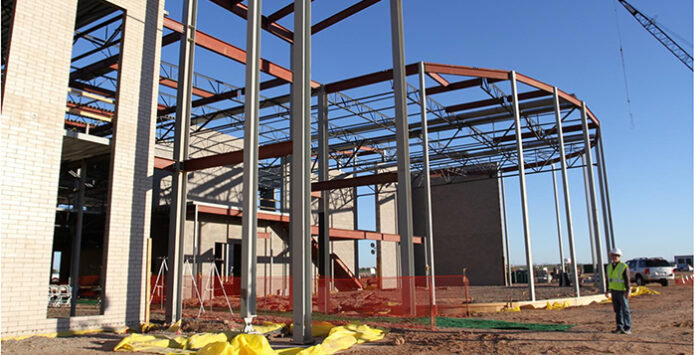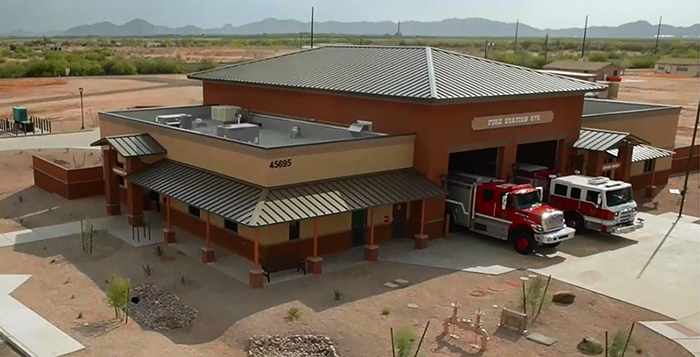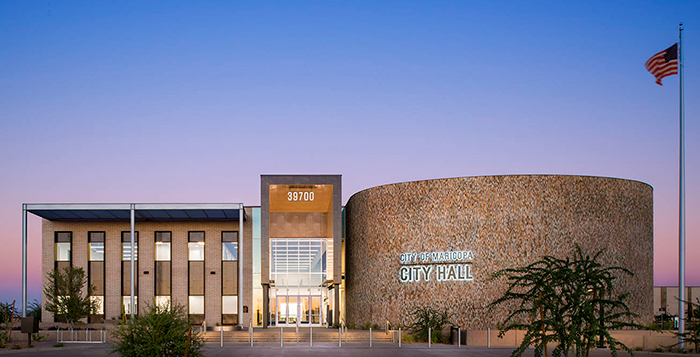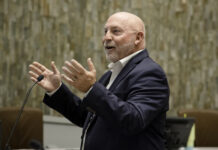
This is the final article of the Planning Maricopa article series, and for many residents the most important – how the City serves all residents efficiently and equitably. Maricopa residents will vote on the General Plan Nov. 8 through Proposition 415.
Planning for public services and facilities enables the City to meet its future population expectations, accelerate growth in desired areas of the community and, if needed, the flexibility to constrain development where growth is not desired. The Public Buildings, Facilities & Services Element of the proposed General Plan expresses how the City will meet the present and future needs of residents and businesses.
The Element outlines the major services and facilities provided by the City and ways to identify future needs and the community’s expectations for services. The Element also highlights goals and objectives designed to help fulfill the current and future needs for:
- Emergency Services (Police & Fire)
- Courts
- Community Services (Libraries, Parks, Recreation, and Events)
- Human Services (Medical & Healthcare)
- Solid Waste Collection & Disposal
- Flood Control
- Education Facilities
- Information Technology (Smart Cities Initiatives, Fiber Optic Infrastructure, GIS)
- Communications
- Utility Services (Sewer, Water, Data, Gas, Electric)
To support the sentiment of Maricopa’s citizens, Planning Maricopa guides City decisions for evaluating needed services and considers alternatives based on measures of equity and efficiency. The proposed General Plan, Planning Maricopa identifies three important criteria for planning City services and facilities:
- Levels of Service standards that are adequate and equitable for all parts of the community;
- Adequate Cost of Development to ensure service to new development is cost-beneficial to existing citizens and funded by new development; and
- Efficient Utility (and facility) Planning to ensure management and financing that maximizes the long term value of the City’s assets.
 Level of Service
Level of Service
A Level of Service (LOS) is not only used for transportation planning, but should also be considered for determining all public and quasi-public services provided in the community. Establishing levels of service is an effective way to ensure the City and utilities are meeting the citizen’s basic needs and expectations, which may change over time. For example, the City can identify how much accessible open space and recreation areas are generally needed per every 1,000 residents. This same principle applies to the amount of public safety personnel necessary to serve the various areas of the community. As the population grows, maintaining a constant LOS assures that facilities and services will keep pace with that growth.
Cost of Development
Developer provided infrastructure, coordinated with the City’s efforts, is a critical component to this Element. City facilities, including streets, trails, utilities, and other improvements are typically constructed by developers with new developments. Additionally, the city collects development impact fees from each new home constructed to pay for the incremental expansion of public facilities to keep pace with the growth new development brings. Fees are collected for streets, police, fire, parks, recreation and library facilities.
The City has long applied the policy for new development to pay its “fair share” for infrastructure and City services, and limit the impacts to existing residents. The General Plan Update, Planning Maricopa, goes steps further to define ways the City can grow to meet the needs of future residents, while limiting the burden on existing residents.
Efficient Utility Planning
Efficient utility planning is an important component of becoming a sustainable community. Well planned utility facilities can provide high quality service at affordable rates, lower construction costs, and reduced maintenance problems. This also considers a density to cost ratio to determine if there will be enough users to justify the expansion or construction of a new utility. To this point, the Land Use and Growth Area Elements encourage a more efficient land use pattern to maximize utility efficiencies, all the while instituting more desirable and higher quality development.
This general Plan Element also incorporates a framework to leverage Smart Cities Initiatives for more efficient services. The citizens of Maricopa desire a “Smart City” approach as a path for enhancing the performance of City facilities and infrastructure, reducing costs and resource consumption, and engaging more effectively and actively with its citizens. This approach integrates technology and government with the intent to empower planning efforts and infrastructure development to create a more attractive and efficient city for residents, visitors, and businesses/employers. “Smart Cities” is an integral aspect of the Vision 2040 Strategic Plan adopted by the City Council in May 2015, sharing equal importance in this General Plan.
Planning Maricopa integrates the State required General Plan elements in ways that leverage land use and public facility decisions to enhance public and quasi-public services in Maricopa. Maricopa Proposition 415 – Planning Maricopa is on the Nov. 8 General Election ballot and early voting has already begun. Maricopa registered voters are encouraged to learn about the ballot items before placing a vote. Visit www.planningmaricopa.com to view Proposition 415 in entirety and make an informed decision this November.


![3 things to know about the new city budget Vice Mayor Amber Liermann and Councilmember Eric Goettl review parts of the city's 2024 operational budget with Mayor Nancy Smith on April 24, 2024. [Monica D. Spencer]](https://www.inmaricopa.com/wp-content/uploads/2024/04/spencer-042424-preliminary-budget-meeting-web-218x150.jpg)






![MHS G.O.A.T. a ‘rookie sleeper’ in NFL draft Arizona Wildcats wide receiver Jacob Cowing speaks to the press after a practice Aug. 11, 2023. [Bryan Mordt]](https://www.inmaricopa.com/wp-content/uploads/2024/04/cowing-overlay-3-218x150.png)



![Alleged car thief released without charges Phoenix police stop a stolen vehicle on April 20, 2024. [Facebook]](https://www.inmaricopa.com/wp-content/uploads/2024/04/IMG_5040-218x150.jpg)

![3 things to know about the new city budget Vice Mayor Amber Liermann and Councilmember Eric Goettl review parts of the city's 2024 operational budget with Mayor Nancy Smith on April 24, 2024. [Monica D. Spencer]](https://www.inmaricopa.com/wp-content/uploads/2024/04/spencer-042424-preliminary-budget-meeting-web-100x70.jpg)


